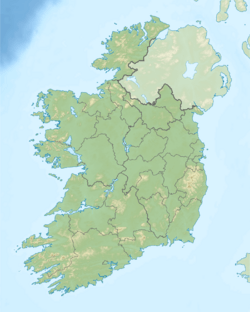Golden Bog of Cullen facts for kids
|
Portach Órga Chuillinn
|
|
| Location | Longstone, Kilcornan, County Tipperary, Ireland |
|---|---|
| Coordinates | 52°30′27″N 8°17′04″W / 52.507500°N 8.284449°W |
| Type | peat bog containing gold and brass artefacts |
| History | |
| Cultures | Atlantic Bronze Age |
| Site notes | |
| Public access | no |
The Golden Bog of Cullen is a very special archaeological place in County Tipperary, Ireland. It was found a long time ago in the 1700s. Experts say it's one of the most important places in Ireland for finding old treasures! Sadly, when it was first found, people didn't know how to properly save old items. So, almost all the amazing things found there were melted down.
Where is the Golden Bog?
The Golden Bog is located about 650 meters (0.4 miles) southwest of Cullen, County Tipperary. It is also about 1 kilometer (0.6 miles) east of a place called Longstone Rath. This area was once part of an ancient Gaelic land known as Uí Cuanach.
Amazing Finds from the Bog
Many interesting objects have been found in the Golden Bog over the years. The first recorded find was in 1731. It was a large brass pot, holding about 9 liters (2 gallons), and it had four legs.
Later, in 1744, a jeweller from Limerick bought a golden crown from a shop in Cullen. This crown weighed about 170 grams (6 ounces) and was made of very pure gold!
Other incredible items found at the site included:
- 300 brass swords
- A golden cone, which was thought to be part of an old wooden statue
- Bars of pure gold
- Golden gorgets (these were special necklaces or collars worn around the throat)
Because these items were found so long ago, before modern ways of studying old objects, most of them were sold to goldsmiths. They were sold just for the value of their metal, called bullion. Today, only one gold item from the bog is known to still exist. It's a dress-fastener or a decorative end piece. You can see it at the Birmingham Museum and Art Gallery.
A Look into the Past
Eugene O'Curry, a famous Irish scholar, thought that the Golden Bog was once a wooded valley. He believed it was a good spot for ancient goldsmiths to work. This was because there was plenty of wood nearby for making charcoal, which was needed for melting metals. He even wondered if there was a goldmine close by!
O'Curry connected the bog to an ancient Gaelic tribe called the Cerdraigi. Their name comes from cerd, an Old Irish word for a skilled craftsperson, especially someone who worked with gold and silver. He also pointed out a nearby townland called Ballynagard. In Irish, Baile na gCeard means "settlement of the goldsmiths," which fits perfectly!
The items found in the bog were probably placed there on purpose. This was likely a type of special ceremony or offering, known as ritual deposition. The people who made and placed these items lived a very long time ago, between about 2000 BC and 400 BC. This time period is known as the Atlantic Bronze Age.


